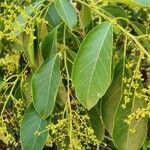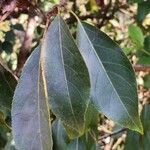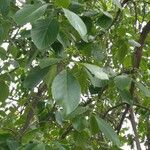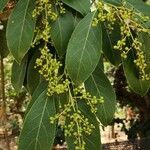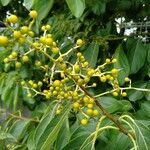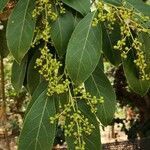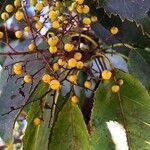Trees to 15 m tall; bark black-gray, laciniate; branches light brown, smooth; branchlets brown, glabrous, with distinct lenticels; axillary buds solitary, compressed. Petiole 1.5-2.5 cm, glabrous; leaf blade elliptic to obovate or oblong-obovate, 5-13 × 4-6 cm, glabrous or sparsely puberulent, base broadly cuneate, margin regularly serrate with teeth curved upward, apex acute, apiculate. Cymes paniculate, 8-15 × 5-8 cm, short pubescent or subglabrous. Flowers crowded, fragrant. Calyx 1.5-2 mm; lobes ovate, ciliate. Corolla white, campanulate, 3-4 mm; lobes spreading, oblong, longer than tube. Stamens exserted; filaments 2-3 mm, inserted on upper part of base, 0.5-1 mm; anthers ovate, ca. 1 mm. Style 1.4-2.5 mm, branches ca. 0.5 mm. Drupes yellow or orange, 3-4 mm in diam.; endocarp wrinkled, divided at maturity into 2 2-seeded pyrenes. 2n = 30, 32, 36.
A medium sized to tall tree. It can grow 10-25 m tall and spread 5-12 m across. It loses its leaves during the year. The stem has deep channels along it. The bark is light grey and develops cracks along it. The young leaves are light green. The leaves are 7-15 cm long by 3-6 cm wide. They are dark green on top and paler underneath. They are oval and thin textured. The edges of the leaves have coarse teeth. The flowers are about 0.5 cm across. They are white and have a sweet scent. The flowers occur on branched clusters 5-20 cm long. These can be at the ends of branches or in the axils of leaves. The fruit is 4-6 mm across. It is round and orange and splits open when ripe. The fruit occur in large numbers. The ripe fruit is edible.
